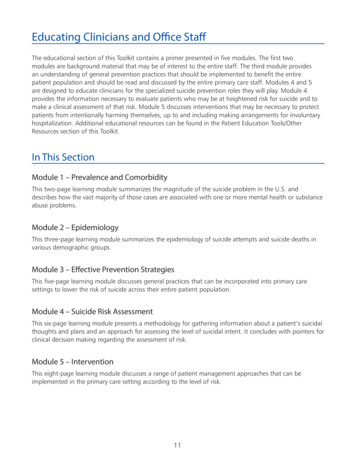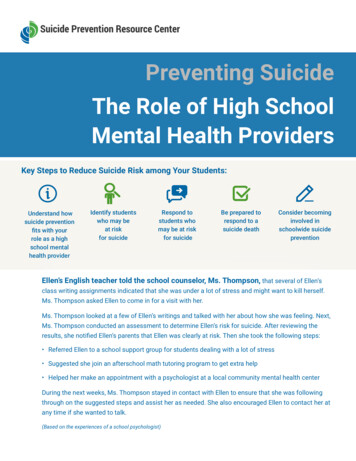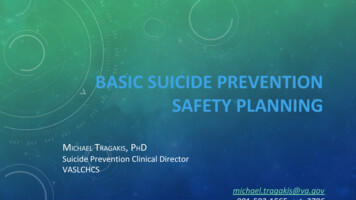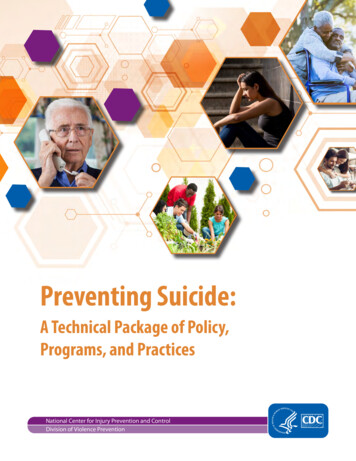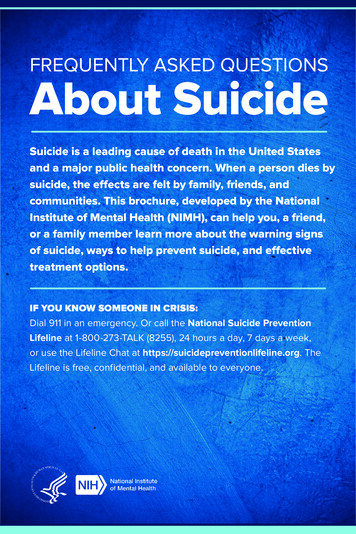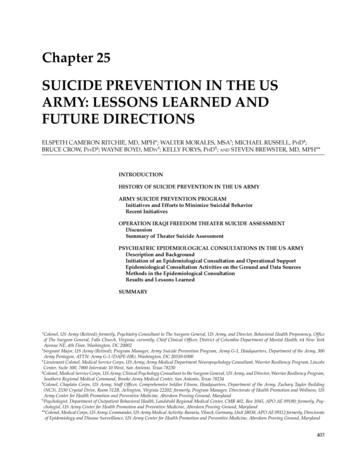
Transcription
Suicide Prevention in the US Army: Lessons Learned and Future DirectionsChapter 25SUICIDE PREVENTION IN THE USARMY: LESSONS LEARNED ANDFUTURE DIRECTIONSELSPETH CAMERON RITCHIE, MD, MPH*; WALTER MORALES, MSA†; MICHAEL RUSSELL, PhD‡;BRUCE CROW, PsyD§; WAYNE BOYD, MDiv ; KELLY FORYS, PhD¶; and STEVEN BREWSTER, MD, MPH**INTRODUCTIONHISTORY OF SUICIDE PREVENTION IN THE US ARMYARMY SUICIDE PREVENTION PROGRAMInitiatives and Efforts to Minimize Suicidal BehaviorRecent InitiativesOPERATION IRAQI FREEDOM THEATER SUICIDE ASSESSMENTDiscussionSummary of Theater Suicide AssessmentPSYCHIATRIC EPIDEMIOLOGICAL CONSULTATIONS IN THE US ARMYDescription and BackgroundInitiation of an Epidemiological Consultation and Operational SupportEpidemiological Consultation Activities on the Ground and Data SourcesMethods in the Epidemiological ConsultationResults and Lessons LearnedSUMMARY*Colonel, US Army (Retired); formerly, Psychiatry Consultant to The Surgeon General, US Army, and Director, Behavioral Health Proponency, Officeof The Surgeon General, Falls Church, Virginia; currently, Chief Clinical Officer, District of Columbia Department of Mental Health, 64 New YorkAvenue NE, 4th Floor, Washington, DC 20002†Sergeant Major, US Army (Retired); Program Manager, Army Suicide Prevention Program, Army G-1, Headquarters, Department of the Army, 300Army Pentagon, ATTN: Army G-1 (DAPE-HR), Washington, DC 20310-0300‡Lieutenant Colonel, Medical Service Corps, US Army; Army Medical Department Neuropsychology Consultant, Warrior Resiliency Program, LincolnCenter, Suite 300, 7800 Interstate 10 West, San Antonio, Texas 78230§Colonel, Medical Service Corps, US Army; Clinical Psychology Consultant to the Surgeon General, US Army, and Director, Warrior Resiliency Program,Southern Regional Medical Command, Brooke Army Medical Center, San Antonio, Texas 78234 Colonel, Chaplain Corps, US Army; Staff Officer, Comprehensive Soldier Fitness, Headquarters, Department of the Army, Zachary Taylor Building(NC3), 2530 Crystal Drive, Room 512B, Arlington, Virginia 22202; formerly, Program Manager, Directorate of Health Promotion and Wellness, USArmy Center for Health Promotion and Preventive Medicine, Aberdeen Proving Ground, Maryland¶Psychologist, Department of Outpatient Behavioral Health, Landstuhl Regional Medical Center, CMR 402, Box 1045, APO AE 09180; formerly, Psychologist, US Army Center for Health Promotion and Preventive Medicine, Aberdeen Proving Ground, Maryland**Colonel, Medical Corps, US Army; Commander, US Army Medical Activity–Bavaria, Vilseck, Germany, Unit 28038, APO AE 09112 formerly, Directorateof Epidemiology and Disease Surveillance, US Army Center for Health Promotion and Preventive Medicine, Aberdeen Proving Ground, Maryland403
Combat and Operational Behavioral HealthINTRODUCTIONThe goal of all the military services is to provide theserving men and women the best available support toassist them in overcoming the stressors that militaryservice entails. The services utilize training andeducation, counseling, intervention, and postventionmeasures to help them find alternative and appropriate ways of dealing with stress and minimize the riskof suicide.The spectrum of suicide behaviors (which rangesfrom gestures to serious attempts to completed suicides) and stress from the high operational tempocontinue to have an effect on readiness and missionaccomplishment. The Army Suicide Prevention Program’s mission is to preserve readiness for soldiers,families, and Department of the Army civilians bycontinuing to develop policies and procedures thatare designed to minimize suicidal behavior. Unfortunately, the Army-wide suicide rate has been trendingupward every year since 2004. The total Army suiciderate in 2009 was 21.7 per 100,000, an increase from therate of 9.8 per 100,000 observed at the beginning ofhostilities in 2001.1This chapter first describes the history of suicideprevention in the Army, then delineates current initiatives and some recent results of the EpidemiologicalConsultation Teams, and provides a theater update.This chapter is focused mainly on the Army becausethe authors are all affiliated with that service. However,all the military services have robust suicide preventionprograms and the suicide prevention managers meetregularly. For example, there is a regular Suicide Prevention and Risk Reduction Committee meeting, formerlyhosted by Health Affairs and more recently by the Defense Center of Excellence. Likewise, there is an annualSuicide Prevention Conference, which in recent yearshas included the Department of Veterans Affairs.HISTORY OF SUICIDE PREVENTION IN THE US ARMYPsychological characteristics and ideas that can leada soldier to engage in a heroic disregard of personalsafety on the battlefield can also lead to self-destructivebehaviors when not at war. In 1897, Emile Durkheimadvanced the first theories of suicide in the military.He defined suicide as those cases of death that resultedeither indirectly or directly from something that thevictim had done, knowing that death would resultfrom this action.2 Of note were those individuals whowere not sufficiently bound to social groups, alienated,and who were said to engage in egoistic suicide. At theopposite end of the psychological spectrum, Durkheimproposed the idea of altruistic suicide, said to be a resultof excessive integration, in which individuals becomeso immersed into social groups that they lose sight ofindividuality and are willing to sacrifice themselvesto the group’s interests, even at the cost of their ownlives. Not surprisingly, the most common cases ofaltruistic suicide were said to occur among membersof the military.3The idea that at least some suicides were preventable evolved slowly throughout the 20th century. Inthe 1930s, Karl Menninger, a psychiatrist, wrote theinfluential book Man Against Himself,4 which extendedFreud’s concept of the death instinct. In the 1950s, twopsychologists, Norman L Farberow and Edwin S Schneidman, introduced several key concepts in suicideresearch and prevention. These concepts led to theopening of the Los Angeles Suicide Prevention Center,which provided a model for immediate consultation,guidance, and assistance to the suicidal person.5404This activity spurred the Los Angeles Countycoroner to first engage mental health professionalsin determining cause of death via a “psychologicalautopsy,”6 which is a methodology for determiningnot just how a person died, but why. It is a diligentprocess that requires gathering information from allavailable records as well as extensive interviews withthose who knew the deceased.7 The US Army reliedon psychological autopsies during the 1990s, but thatprocess has now been replaced by the Army SuicideEvent Report,8 which will be covered in more detailin this chapter. Currently, psychological autopsies areprincipally used to help determine the manner of deathin equivocal cases, that is, when there is a question asto whether it was an accident, suicide, or homicide.The American Association of Suicidology (AAS),founded in 1968, was the first national organizationaimed at understanding suicide and its prevention.9Coincident with this national presence, publicationsdealing with the problem in the military began to appear, although no formal suicide prevention programwas yet established.10Army research psychologists and psychiatrists atthe Walter Reed Army Institute of Research (WRAIR)in Washington, DC, became interested in the causesof suicide among Army personnel and began severalinfluential reviews of suicide deaths.11 In 1988, Colonel Nicholas Rock published an influential 10-yearreview of suicide and suicide attempts in the Army.12A number of articles by Dr Joseph Rothberg and others followed.13–20
Suicide Prevention in the US Army: Lessons Learned and Future DirectionsThe 1980s were a time of increased interest anddramatic progress in military suicide prevention efforts. On November 1, 1985, the Department of theArmy (DA) published DA Pamphlet (PAM) 600–70,Guide to the Prevention of Suicide and Self-DestructiveBehavior,21 which discussed many of the myths ofsuicide and suggested a strategy to prevent selfdestructive behavior. This was followed on September 30, 1988, by DA PAM 600–24, Suicide Preventionand Psychological Autopsy,22 which detailed many ofthe principles of suicide prevention first suggestedby Farberow and Schneidman, and later the AAS.This pamphlet set forth policy and procedures forestablishing the Army Suicide Prevention Program(ASPP) and conducting psychological autopsies. Itprovided guidance for all suicide-prevention activities of the Army and it also provided the rationale,circumstances of use, and guidance for reportingpsychological autopsies.In 1999, the Army contracted with the AAS toproduce Suicide Prevention: A Resource Manual forthe United States Army, 9 which used principles ofcommunity mental health to establish preventionprogramming “intended to save lives and reduce theimpact of self-harm behaviors using a three-tieredapproach to achieve the best-coordinated prevention possible.”9(p3) In general, the first level—primaryprevention—consisted of those command programsdesigned to anticipate critical junctures in a person’scareer and make these less stressful. The next level—secondary prevention—included those commandprograms of special support and crisis counselingneeded when persons encounter times of crisis andmay be helped by a caring professional. The finallevel—tertiary prevention—was designed to provideimmediate care for a potentially life-threateningcrisis, and required care by a mental health professional. These common suicide prevention strategiesare still in use today.In December 1999, the chief of staff, US Army,directed a review of the ASPP. In 2000, the Army G-1(formerly the Army Deputy Chief of Staff for Personnel), in collaboration with the Office of The SurgeonGeneral (OTSG) and the Office of Chief of Chaplains,completed a review and determined that the programwas basically sound, but needed to emphasize leadership involvement and offer more advanced training. In2001, the Army implemented the Suicide PreventionCampaign Plan, which emphasizes preventive andintervention measures, directs commanders to takeownership of the program, and synchronizes andintegrates resources at installation level. More recentefforts by the Army Suicide Prevention Task Forcehave built upon these actions. Despite these efforts,the rate of suicide in the Army has continued to rise(Figure 343519223130414400061215191843Figure 25-1. Active duty suicides in the US Army January 1, 2001, through June 15, 2009. Data includes active duty, ArmyReserve, and Army National Guard. “Pending” data not available for 2001 through 2003.CY: calendar yearData source: US Army G-1, Human Resources Policy Directorate.405
Combat and Operational Behavioral HealthARMY SUICIDE PREVENTION PROGRAMInitiatives and Efforts to Minimize SuicidalBehaviorArmy G-1The Army G-1 is the Army’s proponent for the ASPPand collects demographic data on completed suicides.These data assist the Army G-1, commanders, programmanagers at the installation level, and “gatekeepers”Army-wide in the identification of trends and thedevelopment of new initiatives, tailored and targetedtraining, and policies to minimize suicidal behavior.The ASPP, as detailed in DA PAM 600-24,22 also established a Suicide Prevention Task Force at each installation. In 2006, the Army G-1 formed an “IntegratedProduct Team” to integrate and synchronize effortsat the Headquarters, Department of the Army level.The team met regularly to identify ongoing initiatives,gaps in resources, and trends. Of main concern was theimplementation of tailored and targeted training forsoldiers and leaders.Army programs have focused on training thegatekeepers—leaders, chaplains, behavioral healthofficers, and others. In the October 26, 2005, issue ofthe Journal of the American Medical Association, Mannand colleagues noted:Where the roles of gatekeepers are formalized andpathways to treatment are readily available, such asin the military, educating gatekeepers helps reducesuicidal behavior. Demonstration projects for othergatekeepers with intermediate outcome measures,such as referral rates and psychiatric treatment rates,should be conducted.23To educate gatekeepers, the Army G-1 has contracted with outside organizations like Living WorksEducation and the QPR (Question, Persuade, Refer)Institute from Spokane, Washington, to provide suicideawareness training.For several years, the mainstay of Army suicideintervention was the “Applied Suicide InterventionSkills Training” (ASIST) program,24 a commercial product of LivingWorks, Calgary, Alberta, Canada. In 2002,the Army funded service-wide ASIST workshops25with accompanying computer interactive-trainingsoftware. In 2005, the Army G-1 funded QPR workshops26 Army-wide to provide additional resourcesin suicide-prevention awareness training, prevention,intervention skills, and risk identification to installations throughout the Army. Organizations have theoption to use the training resource that best meets theirneeds; many continue to use Living Works Education,which has certified over 700 “gatekeepers” in suicide406prevention and intervention,25 as their primary training resource. In addition, QPR Institute has certifiedhundreds of trainers in suicide prevention.26The G-1 also conducts many other training activities, to include: Ensuring suicide-prevention training is provided to all deployed soldiers as part of thedeployment cycle support process. Revitalizing the Installation Suicide Prevention Committee/Task Force to adopt Armykey strategies for suicide prevention andactively coordinate with efforts of major subordinate units. Developing and distributing suicide awareness cards that focus on buddy care, warningsigns/risk factors, and resources (the card isa graphic training aid [GTA #12-001-01] thatcan be ordered through the installation andcommunity Training Audiovisual SupportCenter).The Medical Command and The Surgeon GeneralThe OTSG and the US Army Medical Command(MEDCOM) support the ASPP by providing medicalcare, research and data analysis, and assessment ofmedical support systems. In 2007, OTSG established adedicated Suicide Prevention Office within MEDCOMto ensure greater visibility of programs, obtain data,identify trends, and provide timely information toleaders. This office sought to standardize methods andprocedures for future epidemiological consultation(EPICON) teams, improve behavioral health surveillance methods for postmortem review, and continueDepartment of Defense Suicide Event Reports (DoDSER) for suicide attempts and/or completions, whichare reported to the installation suicide preventionprogram manager. However, currently its functionswere subsumed under a new suicide surveillance cellmanaged by the former US Army Center for HealthPromotion and Preventive Medicine (CHPPM), recently renamed Public Health Command (Provisional)or PHC(P). In the subsequent discussion, CHPPM willbe used for past efforts and PHC(P) for current andfuture efforts.CHPPM also supported the ASPP by focusing oncontinuous research and the development of awareness and training resources. For example, during calendar year 2006, CHPPM’s main effort was to distribute2,000 suicide awareness training kits to chaplains. Topics in this training program include suicide awareness,warning signs of suicidal thinking and behavior, and
Suicide Prevention in the US Army: Lessons Learned and Future Directionsintervention skills development.These suicide prevention activities are part of anongoing effort, which includes suicide awarenessbriefings tailored for populations, tip cards, andwarning signs and risk factors cards for distributionduring training. CHPPM developed the acronymACE — “Ask,” “Care,” and “Escort” — to serve as theintervention centerpiece idea to assist buddies whomay be suicidal (Figure 25-2). “Ask” centers aroundthe idea of asking the buddy about state of mind andwhether the buddy is suicidal (ie, “Are you thinkingabout suicide?”). “Care” focuses on employing activelistening skills and understanding the situations toprovide the right mix of resources or help. “Escort”involves not leaving the buddy alone, but rather eitherescorting or finding someone to take this soldier to aprofessional for help.Awareness is a key piece of the ASPP. CHPPM tookthe lead in promoting awareness by the developmentof posters for dissemination throughout the RegularArmy, the Army National Guard (ARNG), and the USArmy Reserves (USAR). In 2007, CHPPM finalized andinitiated distribution of suicide awareness briefingcontent, via chaplains’ channels, to enhance soldiers’Ask your buddy Have the courage to askthe question, but stay calm Ask the question directly,e.g. Are you thinking ofkilling yourself?Care for your buddy Remove any means thatcould be used for self-injury Calmly control the situation;do not use force Actively listen to produce reliefEscort your buddy Never leave your buddy alone Escort to the chain ofcommand, a Chaplain,a behavioral healthprofessional, ora primary care providerFigure 25-2. “ACE” card developed by US Army Center forHealth Promotion and Preventive Medicine.skills in identifying personnel at risk, to assist interventions with the individual, and to provide guidancefor referring or escorting the soldier to professionalhelp. Chaplains and other facilitators can obtain allsupporting materials (ie, tip cards, brochures, posters,briefings) through CHPPM’s suicide prevention ArmyKnowledge Online (AKO) Web site (https://www.us.army.mil/suite/page/334798) and their Health Information Operations Web site (http://chppm-www.apgea.army.mil/hio public/orders.aspx).MEDCOM’s Suicide Risk Management and Surveillance Office (SRMSO) managed the primary tool forsurveillance of Army suicide, the DoDSER, which is areporting and tracking mechanism for completed suicides and nonlethal events that result in hospitalizationand/or evacuation. The original Army Suicide EventReport (ASER) was developed, with initial validationconducted by the US Army Medical Research Unit,Europe, as a means to track in near, real-time, suicidesand suicidal behaviors of Army personnel within theUS Army, Europe.27Following the recommendation of the MentalHealth Advisory Team (MHAT) I,28 MEDCOM issueda policy directing that the ASER be used throughoutthe Iraqi Theater of Operations. The SRMSO, locatedat Fort Lewis, Washington, had operational oversightof the ASER, and conducted routine data analyses andpublished reports of these findings. In 2008, all theservices began using this report form, which becamethe DoDSER. The SRMSO also has responsibility forupdating changes to the DoDSER.The SRMSO has directed that the DoDSER shouldbe completed for all fatalities, hospitalizations, andevacuations where the injury or injurious intent isself-directed. It is not meant to replace the psychological autopsy, which is limited to fatalities in which themanner of death is equivocal, (eg, it is unclear whetherit is an accident, suicide, or homicide). The DoDSERis available at: https://dodser.t2.health.mil/dodser/.(Chapter 24 in this volume discusses suicide surveillance programs.) CHPPM (now PHC [P])assumedoperational control of the Army suicide surveillanceprogram in 2009.Chief of ChaplainsThe Army Chaplaincy continues its “Strong Bonds”program (enriching and developing lasting relationships for both married and single personnel throughthe use of relationship-building seminars and workshops) Army-wide through the efforts of its 1,500 activeduty chaplains and 1,200 reserve component chaplains.Suicide prevention awareness and intervention training continues to be its main effort in support of theASPP. The Chaplaincy provides extensive counseling407
Combat and Operational Behavioral Healthto soldiers and family members, some of whom mayneed to see a mental health professional. The Office ofthe Chief of Chaplains has worked very closely withCHPPM to develop a standardized suicide preventionawareness briefing for all chaplains and leaders. Thistraining support package was completed in 2007,and is now available to all Army chaplains. Furthermore, the ACE (Peer) Suicide Intervention Programfor soldiers and junior leaders is now being taught atthe Chaplain Annual Sustainment Training course.Approximately 200 chaplains received this trainingin 2008.Installation Management CommandGarrison commanders provide support to tenantunits at the installation level. As such, they are chargedwith coordinating suicide prevention activities at theinstallation level. The Installation Management Command (IMCOM) has established the garrison directorof human resources as responsible for ASPP executionat the installation levels. One of the initiatives is toeliminate confusion about the roles and responsibilities in support of the ASPP. Senior leaders throughoutIMCOM support the program by engaging the leadership at the region and installation levels. An additionalsupport to the Army’s ASPP is the establishment ofcommunity health promotion councils (CHPCs) onevery Army installation. The Army, via Army Regulation (AR) 600-63, Army Health Promotion,29 has directedeach Army installation to create a CHPC. The CHPCwill ensure a proactive, coordinated, and synchronizedlocal program. It will be the responsibility of eachCHPC to ensure that suicide prevention activitiesare carried out in accordance with guidance from theArmy’s ASPP plan.Army National GuardThe ARNG coordinates extensively with the activeArmy for training and policy development, workshops, conferences, and marketing. The ARNG SuicidePrevention Program reflects the active Army’s program, with several differences due to the nature of theARNG. The main differences and challenges involvedata collection and availability of resources.Like the active Army, the ARNG program takes aholistic approach that addresses suicide prevention,intervention, and postvention. Leaders and programmanagers initiate proactive measures to prevent suicide within their states by enhancing life skills in areassuch as alcohol and drug abuse prevention, stress andanger management, communication, and conflict resolution training. In addition, personnel receive training408in suicide risk identification and learn procedures forcrisis intervention and referral. And finally, considering the devastating impact a suicide has on those whoknew the deceased, the ARNG suicide preventionprogram includes postvention, which is also knownas “prevention for the next generation.”In April 2007, the ARNG directed that all states appoint a suicide prevention program manager (SPPM)at each Joint Forces Headquarters. Having a programmanager at the state level will allow a greater degreeof suicide surveillance for states, as well as moreaccurate national oversight. The SPPM administersa statewide ARNG Suicide Prevention Program forboth military and civilian leaders, managers, supervisors, soldiers, and family members. Administeringa program of this magnitude requires coordinationwith commanders, surgeons, chaplains, personnelofficers, mental health staff, health promotion staff,and public affairs personnel throughout the state,as well as local agencies and helping services, locallaw enforcement, civilian coroners, and hospitals.The SPPMs receive suicide intervention training andconduct suicide prevention, intervention, and postvention training and awareness activities throughouttheir respective states.The ARNG goal is to provide intervention skillstraining to at least one soldier per company-sizedunit. All soldiers will receive annual suicide awarenesstraining. To maximize valuable resources, the ARNGSPPM has compiled a directory of all ASIST-trainedNational Guardsmen to share with active Army andUSAR. The services often collaborate to provide training to the different components. The state SPPM tracksand reports all attempted and completed suicides to itsstate’s Joint Forces Headquarters and to the NationalGuard Bureau SPPM. The state SPPM identifies trendsand provides decision support when possible factorslead to an increase of suicides.The challenges inherent in collecting accuratedata about the suspected suicide of a soldier servingin a traditional status (“M Day,” or one weekend amonth) lie in the fact that the details of the suicide arecontingent upon reports by family members, medicalauthorities, and local law enforcement investigations.Most ARNG soldiers who died by suicide had beenin a traditional drilling status, rather than on activeduty in a Title 10 status. Although AR 600-63, ArmyHealth Promotion, requires a review to be conductedby a mental health officer for any active or reservecomponent soldier on active duty whose death meetsspecific criteria for suicide or suspected suicide,29(chap5,para5-8)there is no such requirement for ARNG soldiersnot on active duty.In addition to tracking and reporting, the ARNG
Suicide Prevention in the US Army: Lessons Learned and Future Directionsdiffers from the active Army in terms of resourcesavailable. Whereas active duty soldiers deploy fromand return to a post where all resources for supportare usually available without charge, easily identifiable, and in a designated geographic area, the ARNGdeploys from and returns to communities across thestate. Resources available to each ARNG member aredependent on what the local community provides, andtherefore vary from member to member. Because thestate SPPMs are from the local community, they willbe familiar with these local resources. They will ensuresoldiers and families are aware of these resources andare able to identify problems and refer personnel incrisis to an appropriate source of help. This information is included in annual suicide prevention briefingsand published in Army suicide prevention policiesand guidelines.An increasing number of benefits have becomeavailable to all ARNG soldiers. The TRICARE Transitional Assistance Membership Program is availablefor 6 months to ARNG soldiers returning from deployment, with the option to buy in to the TRICARE program for a length of time determined by the amount oftime the soldier was deployed. In addition, all soldiers,regardless of whether they were ever deployed, cantake advantage of Military OneSource (available atwww.MilitaryOneSource.com), which will contractwith a local mental healthcare professional to providesix counseling sessions at no cost to the soldier.The ARNG SPPM has created two suicide-prevention Web sites for soldiers and families. One is publicand can be found at http://www.virtualarmory.com/WellBeing/suicide. The other site is restricted tomembers of the ARNG who have a Guard KnowledgeOnline (GKO) account and password and is located ventionProgram.Army ReservesThe USAR faces all of the challenges described bythe ARNG. Furthermore, their regions are large, andsoldiers are often “cross-leveled” from one area of thecountry into another. Thus gathering accurate data isan enormous challenge. Recent initiatives in the USARhave included: (a) implementing suicide-awarenesstraining into family programs, (b) appointing ASPPmanagers at major subordinate commands, (c) formingcommunity health promotion councils, (d) develop-ing policy guidance for referral of soldiers to mentalhealth, and (e) directing chaplains to develop reportingrequirements for suicide prevention training.Recent InitiativesThe Army Campaign Plan for Health Promotion,Risk Reduction, and Suicide PreventionThe vice chief of staff for the Army established theArmy Suicide Prevention Task Force (ASPTF) in March2009 in response to the Army’s increasing suicide rate.The ASPTF’s effort has resulted in approximately 250tasks throughout the Army that are currently beingexecuted. The resultant effort of the ASPTF has beenpublished as the “Army Campaign Plan for HealthPromotion, Risk Reduction, and Suicide Prevention,”which is directly monitored by the vice chief of staff forthe Army; the tasks identified will substantially changethe way the Army provides care to its extended family.This campaign plan reaffirms the Army’s commitmentto care for its greatest strategic assets—soldiers, families, and civilians.Behavioral and Social Health Outcomes ProgramThe Army has established an epidemiological surveillance program that will utilize the public healthprocess approach to developing a behavioral healthand social outcomes capability. The mission of thePHC(P) Behavioral and Social Health Outcomes Program is to protect combat readiness and soldier healthby addressing psychological and social threats throughsurveillance and in-depth analysis of behavioral healthand disease outcomes; tracking rates and changes intrends in deployed and nondeployed populations;and projecting BH epidemiology. In addition, workingwith the Army G-1, a specialized suicide analysis cellwas funded to conduct suicide-specific analysis andsurveillance in support of the ASPP.In 2008, the Army contracted with the NationalInstitute of Mental Health to assist the Army in acomprehensive research effort that will lead to better prevention strategies and fewer suicides. Thismemorandum of agreement spans over 5 years andrepresents an Army investment of 50 million. TheBehavioral and Social Health Outcomes Program andNational Institute of Mental Health are collaboratingto provide and analyze these data.OPERATION IRAQI FREEDOM THEATER SUICIDE ASSESSMENTThe previous MHATs have reviewed the status ofthe Operation Iraqi Freedom (OIF) theater’s suicideprevention and surveillance program, including ananalysis of completed suicides (see Exhibit 25-1 for409
Combat and Operational Behavioral HealthEXHIBIT 25-1OPERATION IRAQI FREEDOM AND SUICIDE PREVENTIONIn 2003, the Office of The Surgeon
†Sergeant Major, US Army (Retired); Program Manager, Army Suicide Prevention Program, Army G-1, Headquarters, Department of the Army, 300 . US Army; Clinical Psychology Consultant to the Surgeon General, US Army, and Director, Warrior Resiliency Program, Southern Regional Medical Command, Brooke Army Medical Center, San Antonio, Texas 78234 .


